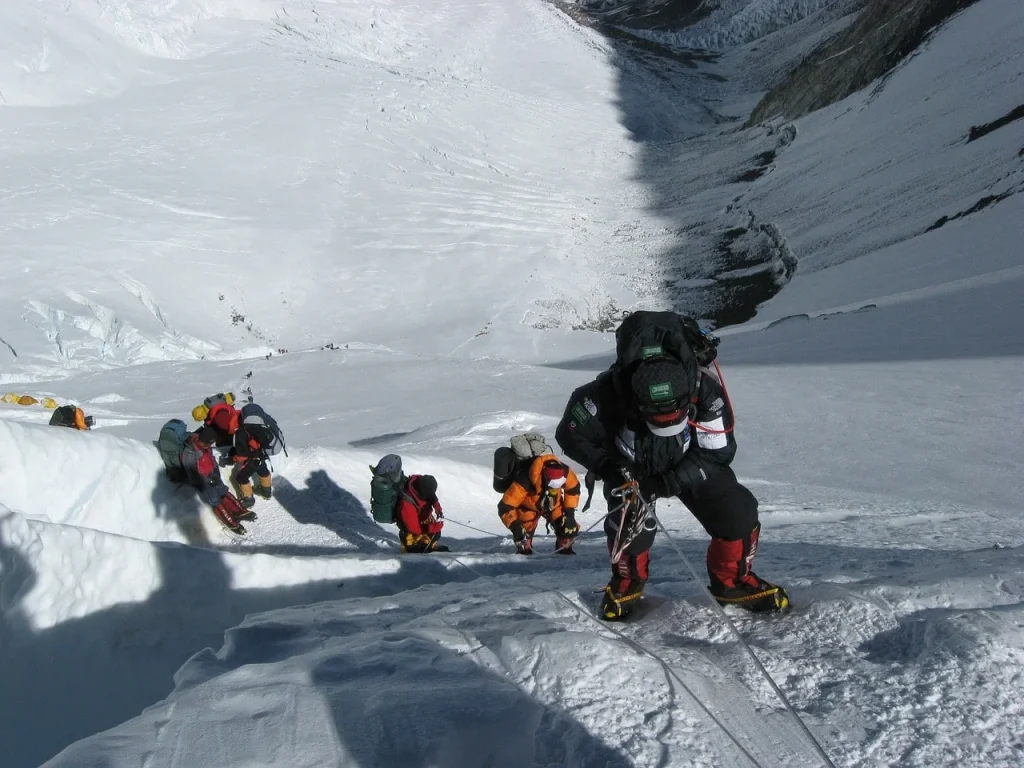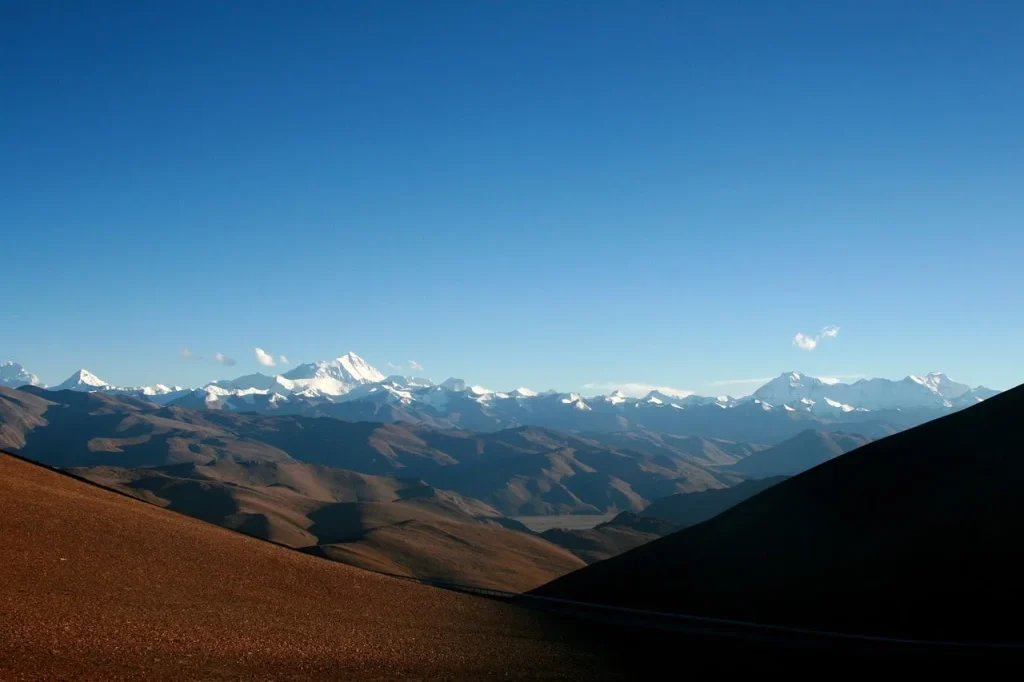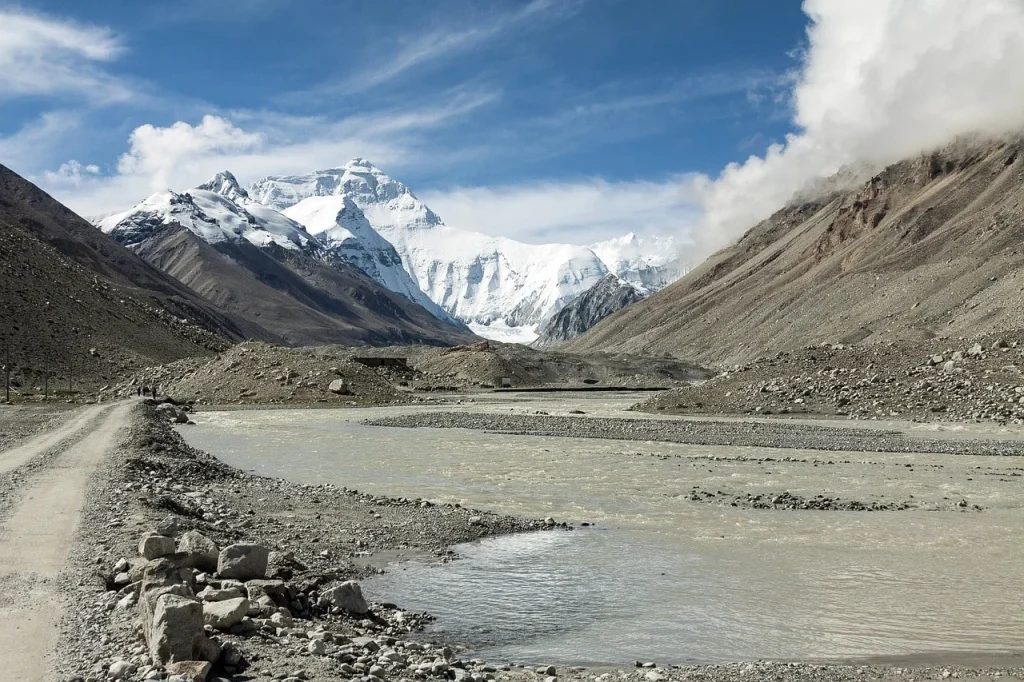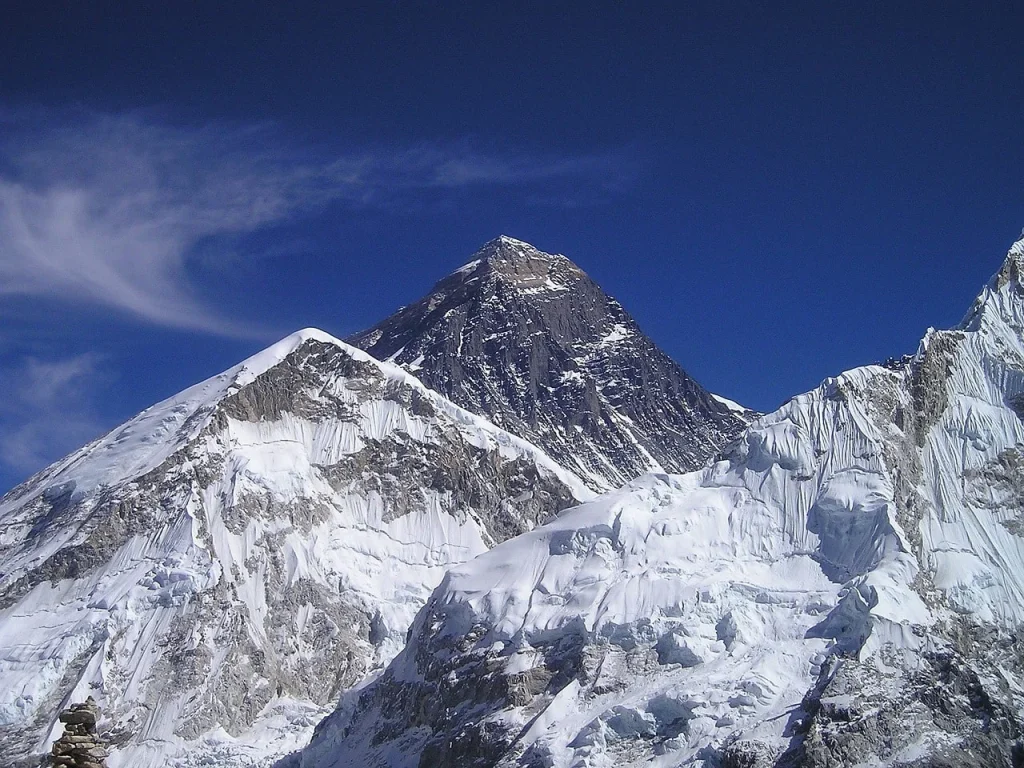Mount Everest, known as the roof of the world, is more than just a mountain; it’s a collection of stories and staggering statistics.
As we enjoy some fascinating facts about Everest, you’ll learn about the geology that shaped it, the climbers who have triumphed and failed, and the impact it has on our planet. This journey will reveal the might and mystery of Earth’s highest peak.
The first question that you will ask and which I must try to answer is this; What is the use of climbing Mount Everest?
George Mallory
Mount Everest Facts
Before diving into the intriguing facts, remember that there’s a quiz at the end of this article. Read carefully to prove your expertise on the world’s highest peak!
- The summit marks the border between Nepal and Tibet.
- Despite its fame, the mountain’s glaciers provide water to 1.4 billion people in Asia.
- Wind speeds can surpass 200 miles per hour at the peak.
- The temperature never rises above freezing, averaging -19 degrees Celsius in the summer.
- A unique species of jumping spider resides at 22,000 feet, making it the highest permanent resident spider.
- More than 200 bodies are on the mountain, serving as macabre landmarks.
- It grows approximately 4 mm higher each year due to tectonic movements.
- The “Death Zone” above 26,000 feet holds low oxygen levels, where the human body deteriorates rapidly.
- Only one-third of attempts to reach the summit are successful.
- In 2005, a helicopter landed on the summit for the first time, setting a world record.
- Google Street View includes a virtual tour of its base camp.
- The 1953 ascent by Edmund Hillary and Tenzing Norgay is considered one of the 20th century’s greatest achievements.
- The mountain’s summit is primarily sedimentary rock formed under the Tethys Sea millions of years ago.

- Trash left by climbers has become such an issue that Nepal has implemented a rule requiring climbers to bring down 8 kg of waste.
- Paragliders have flown from the summit to the base, experiencing the world’s highest such flight.
- The first winter ascent occurred in 1980, performed by a Polish team.
- It was once measured at exactly 29,000 feet high, but surveyors added two feet to avoid the appearance of estimation.
- The youngest person to summit was 13 years old, while the oldest was 80 years old.
- The mountain has moving glaciers that can shift the route up the icefall overnight.
- A 3G data station at base camp allows climbers to send updates and make calls.
- Apocalyptic clouds known as “banner clouds” often appear, flowing like flags from the summit due to airflow disruptions.
- The first recorded ascent without supplemental oxygen was in 1978.
- Lightning is a rare but real danger, with strikes potentially fatal at such high altitudes.
- The indigenous people, the Sherpas, consider it a sacred place, home to the goddess Miyolangsangma.
- The record for the fastest ascent from base camp to the summit is 8 hours and 10 minutes.
- May is the most popular month for summit attempts due to the favorable weather conditions.
- Yak dung is often used at base camp for heating and cooking by Sherpas.
- A weather window in May provides the best chance for climbers to reach the summit before the monsoon season.

- The death rate on the mountain is about 1%, with most fatalities occurring in the Death Zone.
- Khumbu Icefall is considered one of the most dangerous sections due to its shifting ice towers and crevasses.
- It has been climbed by people from over 100 different countries.
- Reinhold Messner was the first to climb it solo and without supplemental oxygen in 1980.
- Fall expeditions are riskier due to the increased likelihood of avalanches.
- The original name in Tibetan, “Chomolungma,” means “Goddess Mother of the World.”
- Satellite imagery helps scientists study the glaciers and environmental changes impacting the mountain.
- More than 4,000 climbers have reached the summit.
- The mountain can be seen from Kathmandu on a clear day, over 200 kilometers away.
- A biological mystery, moss grows at 21,300 feet, one of the highest plant forms ever found.

- Evolutionary changes in local species, such as the bar-headed goose, allow them to fly at extremely high altitudes.
- The first all-female expedition reached the summit in 1975, led by a Japanese team.
- Climate change is causing the glaciers to melt at a rate that threatens future climbing operations.
- A replica of the mountain has been built in an adventure park in Dubai, offering a simulated climbing experience.
- Crowding during the climbing season has led to dangerous “traffic jams” on popular ascent routes.
- The mountain casts a pyramidal shadow onto the clouds during sunrise, a stunning and rare sight.
- Expeditions generate significant revenue for Nepal, amounting to millions of dollars annually.
- Pollution from climbing expeditions affects the local ecosystems and water sources.
- The highest cricket match ever recorded was played on the Gorak Shep plateau, near base camp.
- Survivors of the summit often report experiencing spiritual or life-changing revelations.
- The local belief in the Yeti, or Abominable Snowman, adds a layer of myth and mystery to the region.
- Expeditions have discovered the fossils of sea creatures at over 27,000 feet, proving that the mountain was once underwater.
Mount Everest Myths

Now that we’ve explored Mount Everest, let’s dive into the myths. It’s time to distinguish what’s true from what’s merely a tall tale.
- Everest is the tallest mountain in the world.
It is widely recognized that Mount Everest, standing at about 29,029 feet, is the tallest mountain above sea level. However, when measured from base to peak, Mauna Kea in Hawaii exceeds Everest as it rises over 33,000 feet from its base on the ocean floor. - Only professional climbers can summit Everest.
While it is necessary to have a high level of fitness and preparation, a variety of climbers, not exclusively professionals, have successfully reached the summit. Guidance is usually provided by experienced sherpas and climbing guides. - Climbing Everest is always deadly.
Although risks are inherent in climbing such a formidable peak, the majority of expeditions do not encounter fatal outcomes. Enhanced climbing techniques and improved safety equipment have been developed over time to reduce fatalities. - The climb is pristine and untouched.
Over the years, it has unfortunately been affected by litter left by numerous expeditions. Efforts are continuously made by the local communities and international organizations to clean and preserve its natural state. - Everest is only climbed during the summer.
It is commonly believed that summer would offer the best conditions for climbing; however, the most favored times are during the pre-monsoon season of late spring (April to early June) and the post-monsoon season of autumn (September to November). These periods are preferred due to more stable weather conditions.
No products found.
Mount Everest Quotes

Climbers from all walks of life have attempted to conquer its treacherous slopes, each driven by a unique desire. Let’s read some of their words, exploring the motivations, fears, and triumphs that echo from “the roof of the world.
It is not the mountain we conquer, but ourselves.
Edmund Hillary
A reflection on personal growth and overcoming internal challenges, this quote from Edmund Hillary highlights the profound self-discovery that climbing Everest can evoke.
Everest for me, and I believe for the world, is the physical and symbolic manifestation of overcoming odds to achieve a dream.
Tom Whittaker
Tom Whittaker, who became the first disabled person to reach the Everest summit, speaks to the mountain’s role as a universal beacon for achieving seemingly impossible dreams.
You never climb the same mountain twice, not even in memory. Memory rebuilds the mountain, changes the weather, retells the jokes, remakes all the moves.
Lito Tejada-Flores
Lito Tejada-Flores‘ quote offers a poetic view on the ephemeral nature of climbing and the personal reinterpretation of each climb that evolves in memory.
There is something about building up a comradeship – that I still believe is the greatest of all feats – and binding men together in a common purpose that was stronger than their personal gain and stronger than their personal ambition.
Edmund Hillary
Edmund Hillary reflects on the deep bonds and shared purpose that form among climbers of Everest, suggesting these human connections surpass even the summit itself in value.
If you aren’t in over your head, how do you know how tall you are?
T.S. Eliot
Though not a mountaineer, T.S. Eliot’s metaphorical inquiry captures the essence of challenging oneself with tasks as formidable as Everest to truly measure one’s capabilities and growth.
Mount Everest FAQ

The quiz is nearly here, and so is the FAQ section. Make sure to read through these questions carefully to ensure you’re fully prepared.
- How was Mount Everest formed?
It was formed by the movements of the Earth’s tectonic plates. Specifically, the Indian Plate collided with the Eurasian Plate, causing the land to buckle and fold upwards, which led to the formation of the Himalayas, including Mount Everest. - Why is Mount Everest so dangerous?
It is dangerous due to extreme weather conditions, high altitudes that cause altitude sickness, and challenging terrain. The combination of freezing temperatures, thin air, and unpredictable weather patterns makes climbing very risky. - Can Mount Everest be seen from space?
Yes, it can be seen from space. Astronauts have photographed it from the International Space Station, capturing its massive scale and the extensive mountain ranges surrounding it. - What is the death zone on Mount Everest?
The death zone refers to areas above 8,000 meters (about 26,000 feet) where the oxygen level is insufficient to sustain human life for an extended period of time. The conditions in the death zone are extremely harsh, with low temperatures and thin air. - How long does it take to climb Mount Everest?
Climbing it usually takes about two months. This includes weeks of acclimatization, various ascending phases, and the window for the final summit push, all depending on weather conditions.
No products found.
Mount Everest Trivia

Welcome to the ultimate Mount Everest quiz! Get ready to scale the heights of your knowledge. But beware, if you miss all the questions, you might find yourself on a ‘virtual’ expedition to find a yeti!
Conclusion
We’ve journeyed through the amazing facts about Mount Everest, uncovering the thrills and challenges it presents. As the tallest mountain in the world, it beckons to those seeking the ultimate adventure.
Remember, Everest isn’t just a climb; it’s a discovery of what you can achieve when you set your mind to it. So dream big, stay curious, and embrace the adventures that life throws your way! Till next time, stay curious and explore more. Cheers.
2 Sources Used For This ArticleMount Everest: Everything You Need to Know – Ultimate Kilimanjaro


